Bottom line
Istanbul is an incredibly beautiful and unique city, straddling both Europe and Asia, with plenty to see and eat. It’s a city absolutely worth visiting.
Highlights
My two days in Istanbul comprised:
- Eating a shit-ton of food (Çiya Sofrasi, Kebabpçi Iskender, etc.)
- Rustem Pasha Mosque
- Süleymaniye Mosque
- Blue Mosque
- Hagia Sophia Mosque
- My mom telling me via WhatsApp that I should go to church more frequently
- Topkapi Palace
- Galata Tower
- More baklava than one person should eat in one seating
- A lot of ice cream
Getting to the city from the Istanbul Airport
Upon landing at Istanbul Airport, my first mission was to navigate my way to the Sultanahmet area, where my hotel was located. Several internet sources hailed the metro system as the most convenient method of transportation into the city from the airport. Naturally, I took this to heart because, well, everything you read on on the internet is gospel truth, right? I should have listened to the great Abe Lincoln.

Don’t believe everything you read on the Internet.
The journey started on a promising note with well-marked signs guiding me to the metro station from the airport, even though it felt like a mini-marathon to actually reach there. Once at the station, my initial task was to procure the Istanbulkart, a multi-purpose card granting access to buses, trams, ferries, and more. However, this proved to be a test of patience as a solitary functioning machine played host to a line that seemed to stretch into eternity, all under the unsparing warmth and humidity of a non-air-conditioned space.
Card finally in hand, locating the correct train platform was a breeze, and punctuality seemed to be the train’s strong suit. But this is where the smooth sailing concluded. Reaching the Sultanahmet area was akin to a complex dance: a series of train changes intermingled with station swaps, some even necessitating a street crossing like at Kagithane, which added a somewhat adventurous, if tiring, twist to the journey.

Changing train stations at Kagithane required crossing the street.
I must give credit where it’s due: the trains were pristine and adhered strictly to the timetable. Yet, with the exhaustion from travel settling in, the transitions felt more cumbersome than adventurous.
Retrospectively, during my return trip to the airport, I discovered that while the metro had been a wallet-friendly choice, I wouldn’t have needed to take out a second mortgage to get a taxi ride. For about $30 and well under an hour, I enjoyed a comfortable ride back, a stark contrast to the metro adventure that had cost much less than $10 but took more than 90 minutes, a lot more if you count the time spent queuing for that coveted Istanbulkart (I’m glad I got the card, as it was very useful throughout my visit).
My first day in Istanbul: culinary adventures across continents
Now, I’m going to wax poetic about food.
Prior to arriving in Istanbul, I had booked the “Taste of Two Continents” food tour with Viator. So, on the day of the tour, I arrived early at our meeting point brimming with eagerness to stuff my face with a spectrum of foods, while mentally and physically jotting down spots I’d revisit later during my trip.
Our gastronomic journey began on the vibrant streets of the European side with a walk through the Spice Bazaar. Here, we sampled and purchased a smorgasbord of breakfast delights, including a variety of cheeses, olives, and simit–a kind of spicy, bagel-esque street snack. This was followed by a sumptuous traditional Turkish breakfast spread where we were treated to an array of delicacies, such as milk fat drizzled with honey, different kinds of Nutella, pepper paste, spiced scrambled eggs, sausages, and the aforementioned cheeses, olives, and simit.

The breakfast spread.
Following breakfast, we embarked on a picturesque sail to Kadikoy, located on the Asian side, teeming with an endless supply of Turkish treats. First we sampled midye dolma, stuffed mussels with aromatic rice. While you will find this street food favorite at several locations, one needs to choose more reputable vendors to avoid the unwelcome accompaniment of food-borne illness. As the day progressed, we were introduced to the gastronomic wonders of the delightful Beyran soup, a spicy lamb dish, which was a highlight of the day. Thereafter, we had the kokorec (lamb intestine sandwich) and some boyoz pastries, which were simply fantastic.
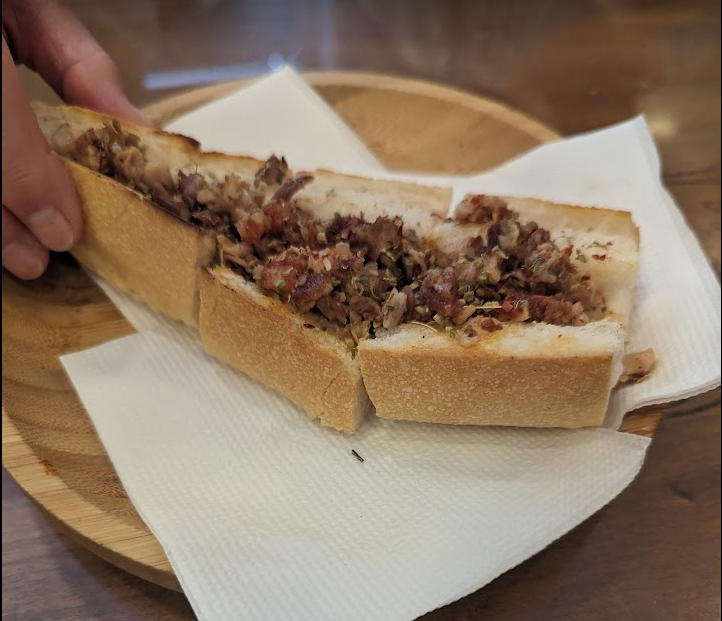
Kokorec: lamb intestine sandwich.
Our adventures continued with not one, but two lunches at the legendary Çiya Sofrasi and Kebapçi Iskender. Amid the bustling streets of Kadikoy, Çiya, which has been featured on the Netflix show, Chef’s Table, is a haven for Turkish culinary traditions, offering an array of authentic dishes, each narrating a different tale from various regions of Turkey. Just a stone’s throw away, we ate at Kebapçi Iskender. The legendary Iskender kebab–tender slices of doner meat generously bathed in tangy tomato sauce, laid on a bed of pita and topped with a hearty dollop of melted butter–did not disappoint. In fact, I enjoyed it so much that I had to return the next day to be delighted again by the fantastic kebab. The grande finale was a heavenly concoction of goat milk ice cream and baklava, which had me wondering if this is what “on earth as it is in heaven” might mean.
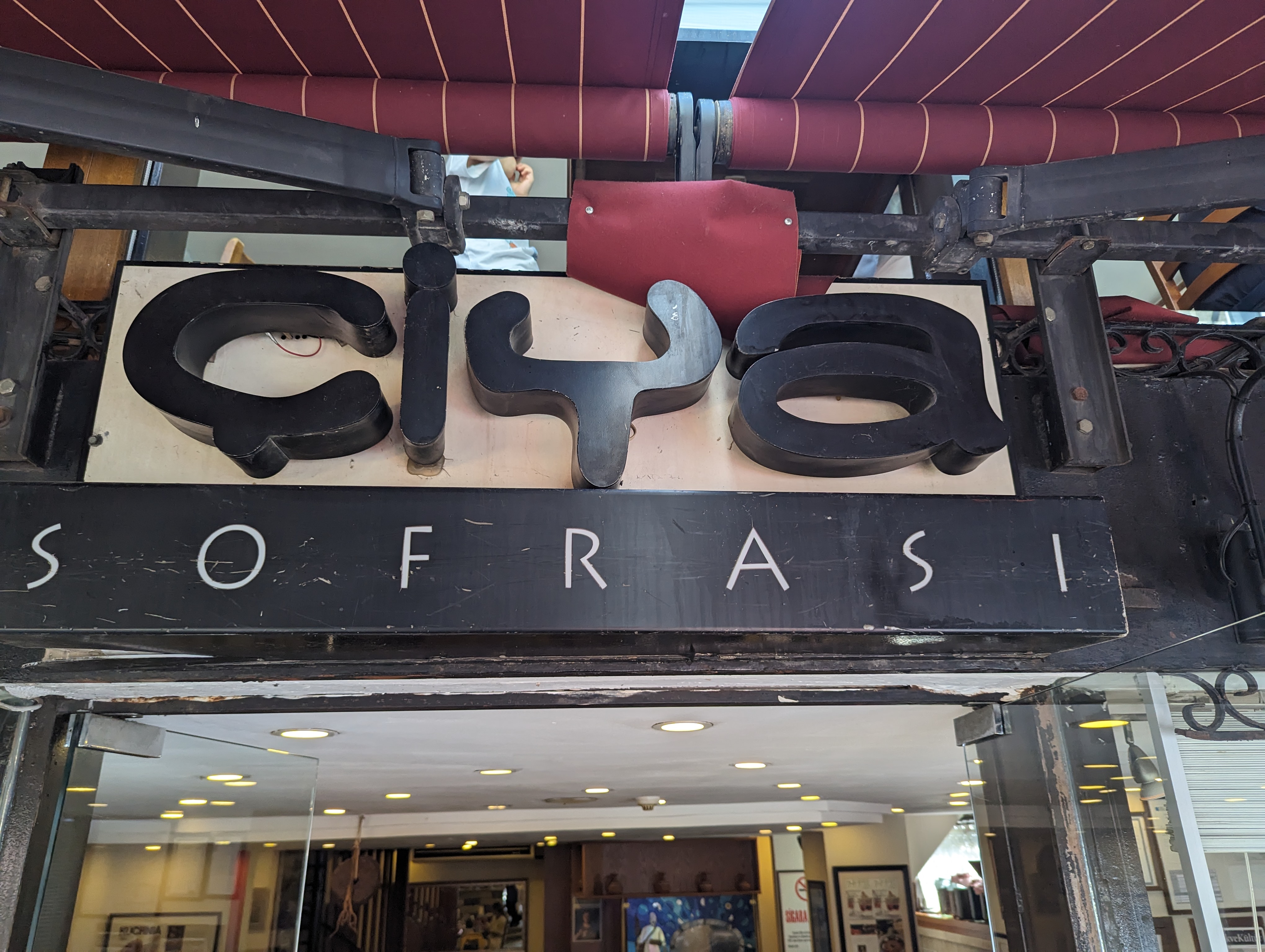
Ciya Sofrasi.
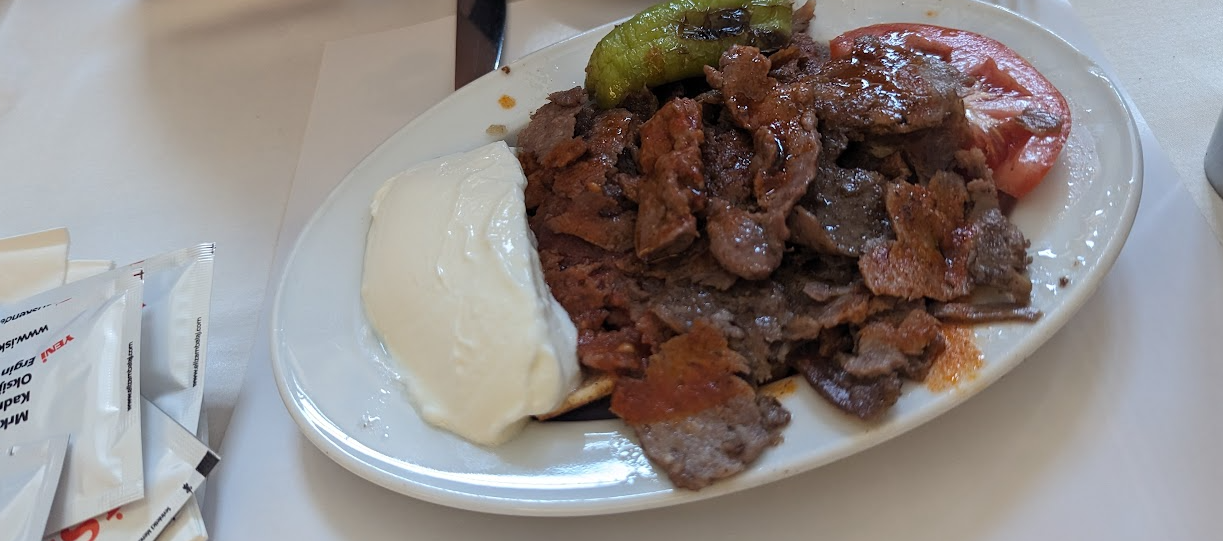
Doner kebab at Kebabpci Iskender.
Sights of Istanbul
Following the food tour, I had quite a bit of energy left in me and decided to see some of the sights that Istanbul had to offer. First, on the recommendation of our tour guide, I visited the somewhat hidden gem of Istanbul - the Rustem Pasha Mosque. Nestled in the bustling streets of the Tahtakale neighborhood, south of the Eminonu Square and near the Spice Bazaar, this mosque is much less touristy and much smaller than its better-known counterparts like the Blue Mosque and Hagia Sophia. The mosque offers a serene escape into the splendid artistry of Ottoman architecture. Despite its austere exterior, the mosque is renowned for its exquisite İznik tiles that adorn its interior walls, displaying intricate patterns and vibrant hues of blue and turquoise.
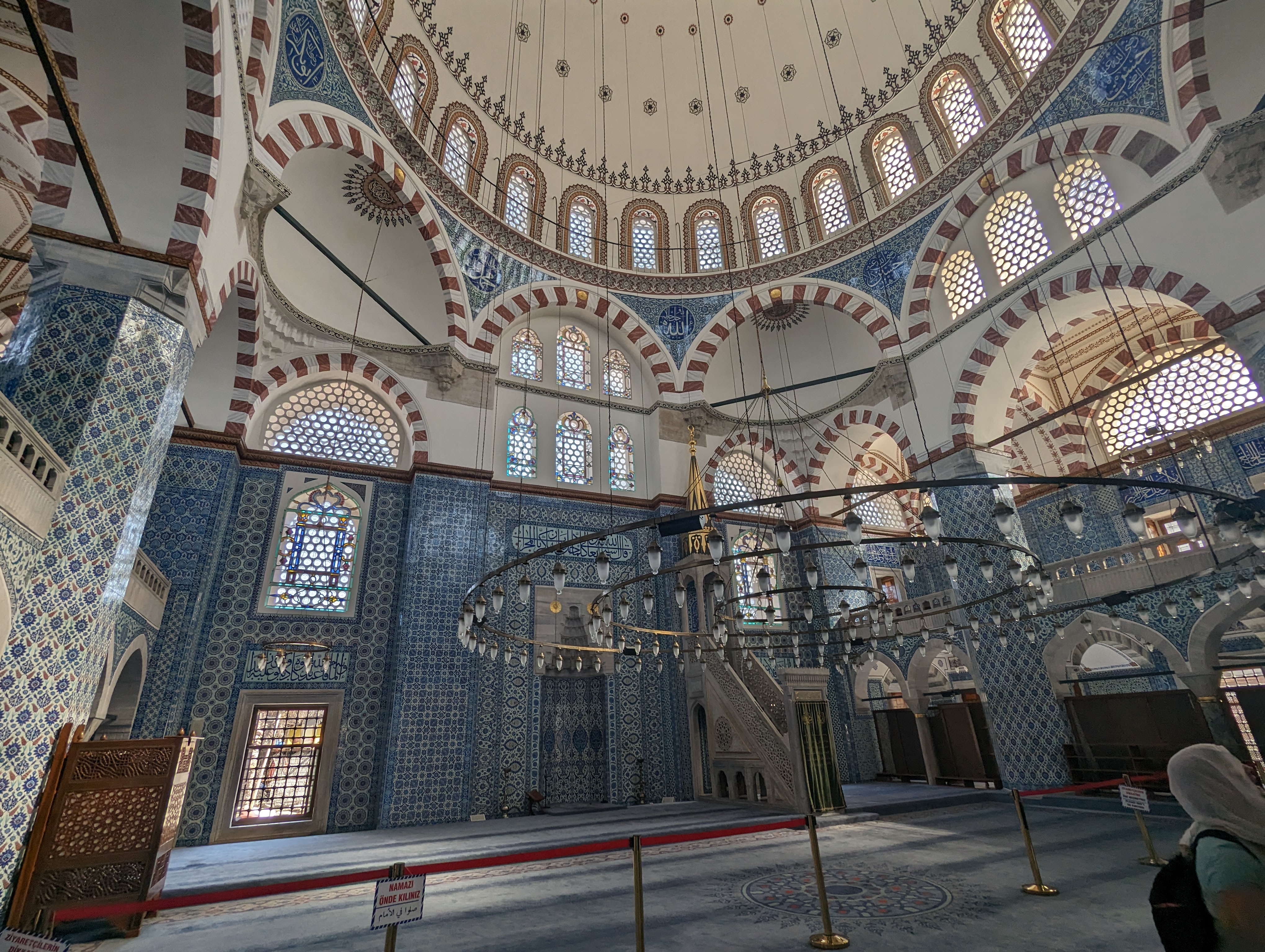
The quiet interior of the Rustem Pasha Mosque.
Next, I visited the Süleymaniye Mosque, an imposing structure that graces Istanbul’s skyline with a blend of classic Islamic and Byzantine architectural elements. As I stepped inside, the mosque greeted me with its understated elegance and grandeur, reflecting the brilliance of the famed architect, Mimar Sinan. Apart from its magnificent domes and minarets, what struck me was its clever use of natural light that illuminated the vast, serene interiors, highlighting the intricate calligraphy and artistry adorning the walls. The mosque also houses a complex of structures including a library, a hospital, and the tombs of Sultan Suleiman and his wife Hurrem Sultan offers a rich insight into the opulent history of the Ottoman Empire.
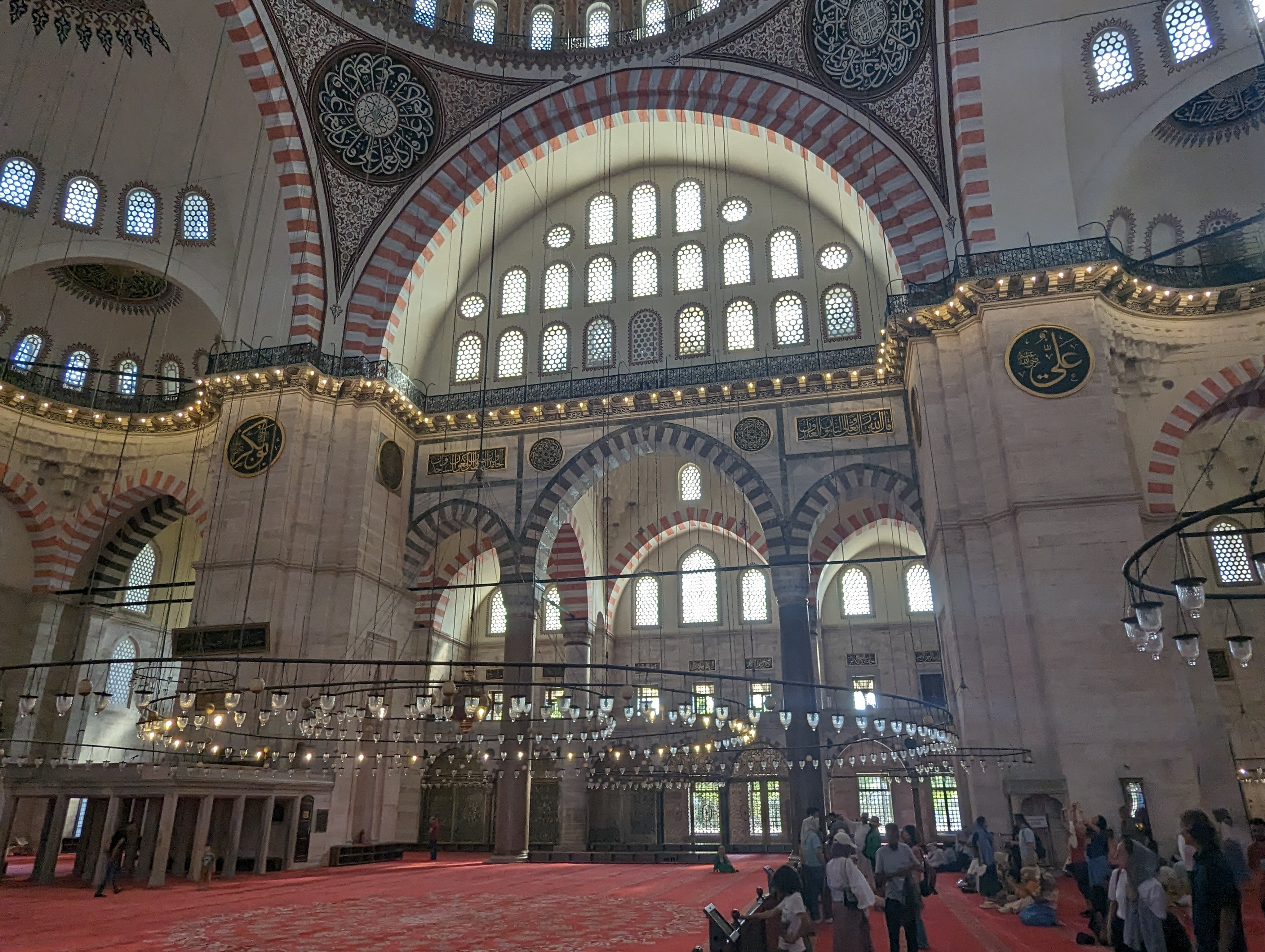
The magnificent Süleymaniye Mosque was a lot less busy than the more popular Hagia Sophia or Blue Mosque.
As I headed back to my hotel walking past Sultahnamet Square, I noticed that while there was a line to get into Hagia Sophia Mosque, there was not much of one to get into the Blue Mosque. So, I decided to go check it out. The Blue Mosque is an awe-inspiring masterpiece adorned with cascading domes and six slender minarets that punctuate Istanbul’s skyline. Its interior, a harmonious sanctuary adorned with more than 20,000 Iznik tiles showcasing various tulip designs in shades of blue, provided a vibrant contrast to the serene spirituality that envelopes visitors upon entry. Upon leaving the Blue Mosque, I joined the fast-moving line to get in the legendary Hagia Sophia, which stands as a testament to the intertwined histories of Christianity and Islam in the region. A walk through Hagia Sophia is like a journey through time, where whispers of the Byzantine and Ottoman empires resonate in the convergence of art and spirituality. I found myself captivated by the grandiose central dome, but slightly put off by the pervasive smell of feet and body odor in the extremely crowded mosque.

The Blue Mosque at night.
At the end of my day, as the vibrant hues of the sunset painted the Istanbul sky, I found my way to Sehzade Cag Kebab, a restaurant in the heart of the Sultahnamet area, where I had what was probably the best kebab I’ve ever tasted. I couldn’t help but reminisce about the day’s adventures–a vivid tapestry of culinary delights and historic wonders set against the backdrop of a city that beautifully marries the ancient with the modern.

Istanbul sunset.
For dessert, I ordered a box of divine baklava, found a place to seat in the Sultahnamet Square, and ate it all, establishing once and for all that “portion control” is just a myth created by people who’ve never experienced truly great baklava!

How much baklava is too much baklava for one person to eat in one seating?
Day two: more sights and foods
My second day in Istanbul began with a fantastic breakast at the Hotel Amira, Istanbul, where I was staying, after which I walked about 10 minutes to the Topkapi Palace. The Topkapi Palace, an extensive residence of Ottoman sultans, is a testament to Istabul’s rich and multifaceted history. Nestled amidst lush gardens, this sprawling complex is rich—both figuratively and literally—with stories steeped in royalty and intrigue. It was easy to lose track of time as I navigated through its opulent courtyards and hallways, each corner seeming to tell narratives from a bygone era. The palace held an incredible collection of art and precious relics, including Prophet Muhammad’s cloak and sword and Moses’s staff (allegedly). I also visited the Ottoman Imperial Harem, once the private dwelling of the sultan, his family, and a substantial entourage of attendants, and a labrinth of stunning rooms, each echoing tales of power, intrigue, and romance. The palace, which I highly recommend spending time in (I spent about three hours), offered a fascinating glimpse into the secretive, yet opulent world that flourished in the heyday of the Ottoman empire.

A room in the Topkapi Palace.
After the TopKapi Palace, I walked about 45 minutes across the Galata Bridge to the Karakoy area. Although it was hot and humid, the walk itself was pretty neat, giving me clear and beautiful views of the towering minarets amidst the beautiful city. The bridge seemed like the perfect spot to capture the vibrant life along the Bosphorus before heading to the main attraction, the Galata Tower. When I got to the tower, I was blown away by the downright amazing views of Istanbul it offered. From the top of the tower, the city looked like a sprawling canvas of history meeting modern times, giving me a dynamic picture of its vibrant and ever-changing rhythms of daily life.

Approaching the Galata Tower.

The Galata Tower offers incredible views of the city.
Following a visit to Galata Tower, I walked back across the bridge to catch the ferry to the Kadikoy, the Asian side, where I went back to Kebapçi Iskender for a second taste of the outstanding doner kebab. Thereafter, I had a generous serving of kunefe–a pastry soaked in sweet syrup and layered with cheese–with a side of ice cream for dinner, after which I had some Turkish ice cream as dessert to my dessert dinner. Indeed, as the popular saying goes, “there is no such thing as too much ice cream.” Ok, I just made that up, but it’s true since it’s now on the internet.

Dinner: kunefe with a side of ice cream.
The video below describes some of the foods I ate during the food tour.